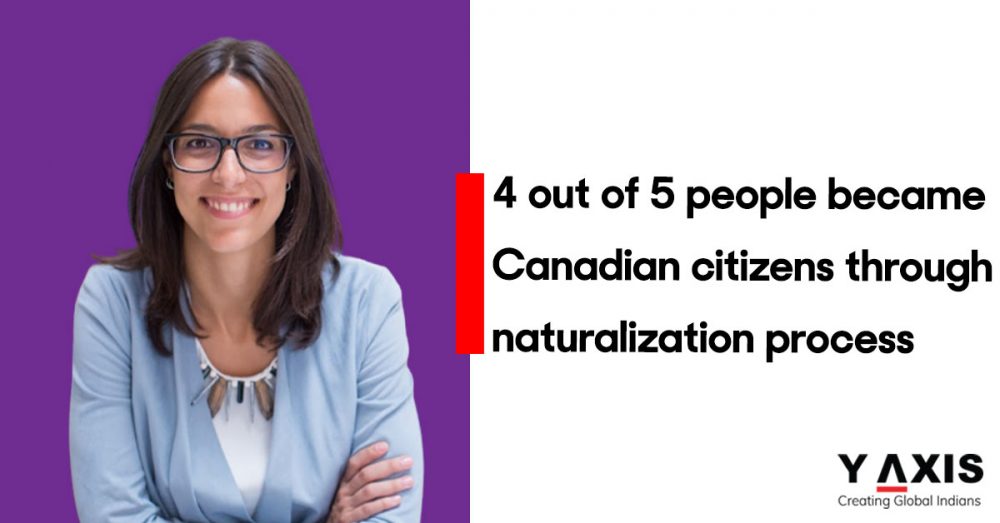Posted on November 17 2022
4 out of 5 people became Canadian citizens through naturalization process
By , Editor
Updated June 27 2024
Highlights of 4 out of 5 are Canadian citizens through the naturalization process
- Out of 33.1 million Canada population, 91.2% are citizens either by naturalization process or by birth.
- The rest 8.8% of people in Canada are non-Canadians which means either Temporary residents or Permanent residents.
- Every 4 out of 5 eligible immigrants which means 80% of the immigrants received Canadian citizenship through the naturalization process.
- The average age of Canadian citizens living in Canada was 41.2 years and whereas non-Canadians age is 33.6 years.
- The most reported citizenship that is heard among the Temporary residents and Permanent residents was Indian.
Most of Canada’s population is now citizens
The recent census on the trends of receiving Canadian citizenship for foreign immigrants is provided by Statistics Canada.
A glimpse of Canadian population
Based on the 2021 census, of a total of 33.1 million population in Canada, most of the citizens (91.2%) either by naturalization process or by birth. The remaining 8.8% of people in Canada were non-Canadian, let them be Temporary or Permanent residents.
The naturalization process is that non-Canada resident in Canada becomes eligible and gets a legal status of a citizen which is a path to obtaining citizenship for immigrants.
The percentage of the Canadian people who are citizens by birth in Canada has decreased since 1991, whereas the percentage of Citizens by naturalization in Canada, and who are not citizens in Canada has been increasing.
*Check your eligibility criteria for Canada through Canada Y-Axis Score Calculator.
Naturalization process of getting Canadian citizenship for a non-Canadian
Based on the 2021 census, every four out of five 80% of the qualified and eligible immigrants obtained Canadian citizenship using naturalization. But compared to 2011 the rate of naturalization is less, it was 87.8% in 2011.
The decrease in the naturalization rate is one of the main reasons for the Canadian government to ease the immigration policies and also there were exaggerations in terms of policy changes in Canada which conclude that Canada has moved to its correct form.
*Need assistance to apply for Canadian PR visa? Then get professional guidance from Y-Axis Canada overseas immigration expert
For example:
- The physical presence requirement for the naturalization process has been changed between the years 2015 and 2017 by maximizing it from 3 to 4 years and by leaving no chances of claiming the time spent as TR.
- After the revamping of the Citizenship Act in 2017, the physical presence requirement was lowered down to thin three years with a provision for applicants claiming the term they stayed as a temporary resident (TR) in Canada.
- In the year 2015, the citizenship grant free was increased. The liberal government announced waiving the fees to decrease financial burdens on low-income families in 2019. Once it is waived they will be eligible for the naturalization process.
- Other than this, other affecting variables include modification in dual citizenship for the immigrant’s source country, like specific conditions to stay for non-Canadian residents.
*Do you want work in Canada? Speak to Y-Axis overseas Canada immigration career consultant for guidance.
Also read…
Canada adds 108,000 jobs in October, StatCan Reports
Canada to invest $1.6 billion for the settlement of new immigrants in 2023-2025
Canadian Citizenship – the natural move
Although there was a decline in the rate of naturalization in the last 10 years, similarly there is a steady increase in the country where people are showing more interest in pursuing citizenship.
The immigrants who came to Canada before 2001, have received 94% Canadian citizenship by 2021. Whereas the immigrants who came to Canada between 2011 – 2015 more than 50% of people received citizenship in Canada.
The key finding in these statistics is there is a natural process that will either help you in gaining Canadian citizenship as soon as you are found eligible for it or sometimes when time passes by, can receive Canadian citizenship.
The non-citizens and their needs in the country
The median age of Canadian citizens living in the country is 41.2 years, and the median age of non-Canadian citizens (either TR or PR) living in the country is 33.6 years.
At present Canada is in a crucial stage due to the low birth rate, and aging of the population, Canada has to choose another option for addressing the workforce shortages and the market needs using immigration.
Hence, immigrants who possess prime working age can have options of becoming permanent residents and citizens is one of the key elements of Canada’s growth in socio-economic ways.
What would be the birth country of the Canadians tomorrow?
- Among the current PRs and TRs, the most reported nation or citizenship was from India.
- Every 1 in 10 PRs and TRs reported is Chinese citizenship along with the Philippines.
- The third most common nationality in the list of non-PRs was French.
- This shouts that Asia will continue to be one of the key players in the source region of not just the immigrants but the future citizens of Canada.
Apart from this, there is an increase in the number of non-PRs who were French and have been meeting the policies of both the Federal and Quebec governments, hence government plans to increase immigration allocations for Francophone and across Canada.
Conclusion
Immigration stays one of the key concerns for Canada, the declining rate of naturalization will become the focal point for the IRCC and the Federal government hereafter. Especially the median age of non-Canadians who are within the prime working ages. Canada has already paved ways to increase the rates of immigration with the new Immigration Levels plan.
Do you have a dream to migrate to Canada? Talk to World’s no.1 Y-Axis Canada overseas migration consultant.
Also Read: Canada targets 1.5 million migrants by 2025
Tags:
Canadian citizens for naturalization process
Migrate to Canada
Share
Options for you by Y-Axis
Get it on your mobile
Get News alerts
Contact Y-Axis

